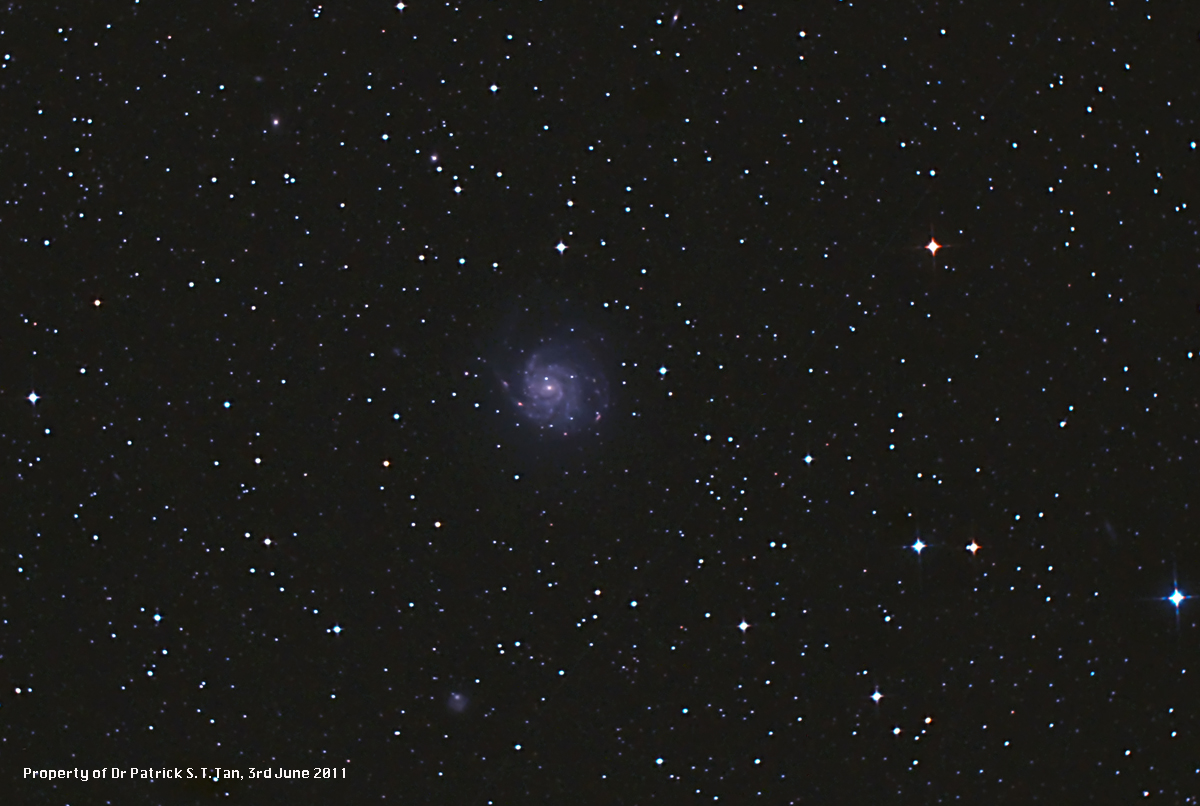
M101 widefield
Date: 03/06/11 Time: 2330hrs Location: Sunningwell Temperature: 17.3ºC Relative Humidity: 62%
Camera: Nikon D80 Scope: William Optics Z66 Apo Doublet at prime focus Field-flattener: William Optics VIII 0.8x focal reducer Mount: piggy-backed on Meade LX90 in equatorial mode Filter: Astronomik CLS (LPF broadband filter) Exposures: 5 + (8x10) + 12 minutes ISO: 1600 F ratio: 5.9 Guidance: Autoguided
I already have an earlier picture of M101 taken with my DSI. This famous face-on spiral galaxy also known as the Pinwheel Galaxy lies in Ursa Major, forming an equilateral triangle with the stars Mizar and Alkaid on the western side, and occupies approximately 22 arc minutes of diameter in the sky, about half the size of the full moon, but is notoriously difficult to view. This reduced view has caught a few of the HII (red because of the H-α emission of ionised hydrogen) star forming regions in the peripheral arms of the galaxy. M101 lies approximately 25 million light years away and stretches 170,000 light years across in diameter - just under twice the diameter of our own Milky Way which it resembles. M101 and nearby M63 (Sunflower) and the famous M51 (Whirlpool) are a few of the nearby galaxies of the Virgo supercluster - a collection of 100 or more galaxies within a 110 million light year stretch, and one of many superclusters in the observable universe. I make this point in order to point out the unimaginably vast number of stars around which rocky planets with atmospheres might have formed and the LIKELIHOOD of evolved life developing elsewhere - even if we can never make direct contact due to the separation of both time as well as distance.
This is the first use of a field-flattener with my astrophotographic set-up. Instead of the standard SCT nose fitting on which the Nikon T-ring and the filter is attached, the field flattener is used - it has an SCT nose fitting on one end to take a 2" filter and the Nikon T-ring is threaded in on the opposite side to take the camera. Those of you who have been following this series of widefield photographs would have noticed the problems with radial elongation and loss of focus of stars in the peripheries of the preceding photographs. I had concerns about increasing the weight on my LX90 and also difficulties with achieving prime focus by adding another set of compound lenses to the array, but after a discussion with Ian King on the telephone, I purchased this beautifully precision-engineered product which has been a great success. Click here to see the flattener. Although the field is not 100% flat, the sweet spot of focus is very much enlarged to enable so much more of the entire picture to be utilised in the final crop.
This picture has the cumulative exposure time of 97 minutes in 10 separate exposures. Each of the 10 exposures required its own subtraction mask for light pollution because this particular evening was very unsettled with poor seeing and high atmospheric moisture as we transitioned from a high-pressure zone to low. There were gusty winds which, thankfully, did not cause too much vibration. Following subtraction, the frames were combined in Maxim DL and the resulting photo treated to my (standard) processing in Photoshop.
HOME PICTURES: Solar system PICTURES: Wide field